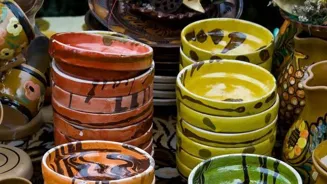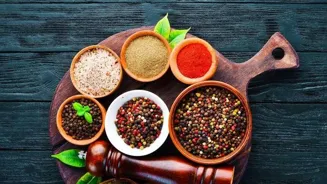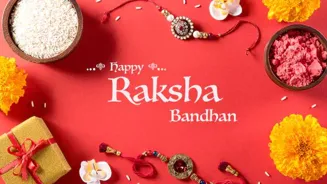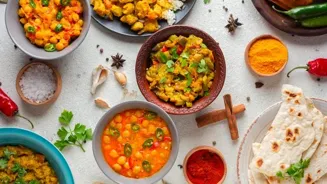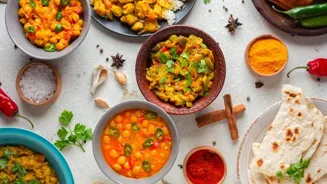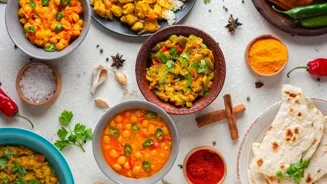Discover the essence of Indian festivals through food! Dive into the traditions and recipes that bring communities together
India, a land of vibrant cultures and traditions, celebrates numerous festivals
throughout the year. And what's a festival without food? Food plays a central and sacred role in almost all Indian festivals.
It’s not just about satiating hunger; it’s about offering gratitude, celebrating togetherness, and preserving cultural heritage. Each festival has its own set of signature dishes, prepared with devotion and shared with family, friends, and the community.
The aromas that waft from kitchens during these festive times evoke a sense of nostalgia and joy.
Food symbolizes occasions, traditions, and community spirit
From the sweets that symbolize auspicious beginnings to the savory snacks that tantalize the taste buds, food reflects the spirit of each occasion. Ingredients often carry symbolic meanings, representing prosperity, happiness, and good fortune.
For instance, rice is a staple ingredient used in various forms, symbolizing abundance and fertility. Ghee, the clarified butter, is considered pure and sacred, often used in offerings and preparations.
The act of preparing and sharing food during festivals strengthens social bonds and reinforces community spirit. It's a time when families come together, passing down traditional recipes and culinary skills to the next generation.
The preparation of festive food often involves elaborate rituals and meticulous attention to detail, ensuring that each dish is perfect. This collective effort adds to the festive atmosphere and creates lasting memories.
The significance of food extends beyond mere consumption; it embodies cultural values and connects people to their roots.
Diwali and Holi: Festive delights of sweets, snacks, and sharing
Diwali, the festival of lights, is synonymous with sweets and snacks. Laddus, barfi, and peda are just a few of the sweet treats that adorn every household. Savory snacks like mathri, chakli, and namak pare add a delightful contrast to the sweetness.
The act of exchanging these delicacies with neighbors and friends embodies the spirit of sharing and goodwill. Holi, the festival of colors, is celebrated with vibrant hues and equally colorful food. Gujiya, a sweet dumpling filled with khoya and dry fruits, is a quintessential Holi treat.
Thandai, a refreshing milk-based drink flavored with almonds, saffron, and spices, helps cool down the exuberance of the celebrations. The use of saffron in thandai is considered auspicious and adds a touch of luxury to the drink.
Other popular Holi snacks include dahi bhalle, kanji vada, and papri chaat, offering a diverse range of flavors to complement the festive mood. The preparation of these dishes often involves the entire family, creating a sense of togetherness and anticipation.
Each dish is carefully crafted, reflecting the joyous and playful spirit of Holi. The exchange of food and sweets is an integral part of the Holi celebrations, fostering a sense of community and friendship.
Navratri festival: fasting, feasting, special meals for Goddess Durga
Navratri, a nine-night festival dedicated to Goddess Durga, involves fasting and feasting. During the fast, people abstain from certain foods and consume sattvic meals made with ingredients like singhara (water chestnut flour), kuttu (buckwheat flour), and sabudana (sago).
Sabudana khichdi, kuttu ki puri, and singhare atte ka halwa are popular dishes consumed during this period. After the fast, a special meal called "kanya pujan" is prepared for young girls, who are considered embodiments of the Goddess.
This meal typically includes poori, chana, and halwa, symbolizing nourishment and respect. The act of offering food to the young girls is considered highly auspicious and brings blessings to the family.
The Navratri fast is not just about abstaining from food; it’s also about cleansing the body and mind. The sattvic food consumed during this period is believed to be light and easily digestible, promoting physical and spiritual well-being.
The focus on simple and nourishing ingredients during Navratri highlights the importance of mindful eating and respecting the traditions associated with the festival. The breaking of the fast with a special meal is a celebration of devotion and gratitude.
Janmashtami celebration with bhog of sweets, symbolizing devotion to Lord Krishna
Janmashtami, the birth of Lord Krishna, is celebrated with great enthusiasm and devotion. A special bhog (offering) is prepared for the deity, which includes various sweets and savory dishes. Makhan mishri (butter and sugar) is a symbolic offering, representing Lord Krishna's love for butter.
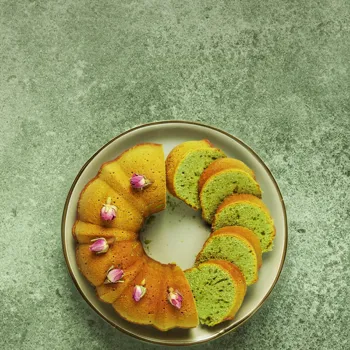
Other popular dishes include panjiri (a sweet dish made with whole wheat flour, ghee, and dry fruits), dhaniya panjiri (made with coriander powder), and peda. The bhog is first offered to Lord Krishna and then distributed as prasad to devotees.
The preparation of the bhog is considered a sacred task, performed with utmost care and devotion. The ingredients used are pure and fresh, and the dishes are prepared according to traditional recipes.
The act of offering food to Lord Krishna is a symbol of love and devotion, seeking his blessings for prosperity and well-being. The sharing of the prasad strengthens community bonds and reinforces the spirit of togetherness.
Raksha Bandhan celebrates sibling bonds with food, love, and togetherness
Raksha Bandhan, the festival celebrating the bond between siblings, is marked with a delicious spread of food. Sisters prepare their brothers' favorite dishes, expressing their love and affection. Sweets like kheer, gulab jamun, and rasgulla are common treats.
Savory snacks like samosas, kachoris, and dhokla add to the festive feast. The act of feeding each other sweets symbolizes the sweetness of the sibling bond. The Raksha Bandhan meal is a celebration of family and togetherness, reinforcing the special connection between brothers and sisters.
It's a time when families come together to share a meal, exchange gifts, and create lasting memories. The preparation of the meal is a labor of love, with sisters putting in extra effort to make their brothers feel special.
The sharing of food is an integral part of the Raksha Bandhan celebrations, symbolizing love, care, and protection.
Pongal festival celebrates harvest, community, and gratitude through traditional dishes
Pongal, a harvest festival celebrated in South India, revolves around gratitude for a bountiful harvest. The main dish, also called Pongal, is prepared with freshly harvested rice, milk, jaggery, and moong dal.
It is cooked in a traditional clay pot until it overflows, symbolizing prosperity and abundance. Other festive dishes include vadai, payasam, and sambar. The preparation of Pongal is a community affair, with families coming together to celebrate the harvest season.
The overflowing of the Pongal dish is considered an auspicious sign, promising good fortune for the coming year. The festival is a celebration of agriculture and the hard work of farmers, expressing gratitude for the gifts of nature.
The sharing of food is an integral part of the Pongal celebrations, fostering a sense of community and togetherness. The use of fresh and seasonal ingredients highlights the importance of respecting the bounty of the earth.
Pongal is a time to celebrate the harvest, express gratitude, and strengthen community bonds through the sharing of food and traditions.
AI Generated Content. Glance/InMobi shall have no liability for the content